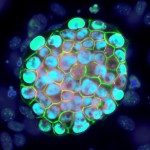Link to Pubmed [PMID] – 10655231
Genetics 2000 Feb;154(2):803-11
The Om locus was first described in the DDK inbred mouse strain: DDK mice carry a mutation at Om resulting in a parental effect lethality of F(1) embryos. When DDK females are mated with males of other (non-DDK) inbred strains, e.g., BALB/c, they exhibit a low fertility, whereas the reciprocal cross, non-DDK females x DDK males, is fertile (as is the DDK intrastrain cross). The low fertility is due to the death of (DDK x non-DDK)F(1) embryos at the late-morula to blastocyst stage, which is referred to as the “DDK syndrome.” The death of these F(1) embryos is caused by an incompatibility between a DDK maternal factor and the non-DDK paternal pronucleus. Previous genetic studies showed that F(1) mice have an intermediate phenotype compared to parental strains: crosses between F(1) females and non-DDK males are semisterile, as are crosses between DDK females and F(1) males. In the present studies, we have examined the properties of mice heterozygous for BALB/c and DDK Om alleles on an essentially BALB/c genetic background. Surprisingly, we found that the females are quasi-sterile when mated with BALB/c males and, thus, present a phenotype similar to DDK females. These results indicate that BALB/c alleles at modifier loci increase the severity of the DDK syndrome.

